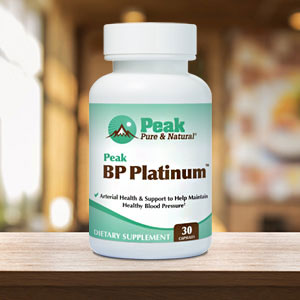Get Easy Health Digest™ in your inbox and don’t miss a thing when you subscribe today. Plus, get the free bonus report, Mother Nature’s Tips, Tricks and Remedies for Cholesterol, Blood Pressure & Blood Sugar as my way of saying welcome to the community!
The sneaky substances raising women’s blood pressure

At this point, you’re probably familiar with per- and polyfluoroalkyl substances (PFAS). These manmade substances are known as “forever chemicals” because they never degrade in the environment, and end up contaminating our water, soil, air and even our food.
Despite recent efforts to curb them, PFAS are in pretty much in everything we use and consume. For instance, if you buy new clothes, get takeout, use cosmetics, personal care or cleaning products or have nonstick cookware or stain-resistant furniture and rugs, you’re very likely exposing yourself to PFAS.
Scientists are finding that as more of these PFAS build up in our bodies, they can cause health problems such as celiac disease, liver damage and decreased fertility and raise your risk of diabetes, obesity, asthma and thyroid disease. Now, recent research has added another potential issue to that ever-growing list of health concerns….
Forever chemicals raise blood pressure
Researchers used data from a prospective study of women at midlife to examine blood concentrations of specific PFAS and how they relate to the risk of high blood pressure. The data included more than 1,000 women ages 45 to 56 who had normal blood pressure when they enrolled in the study — and were followed up with annually for over 18 years.
According to the analysis, women with higher concentrations of specific PFAS were more likely to have developed high blood pressure during the follow-up period.
For instance, women in the highest third in terms of their blood concentration of perfluorooctanoic acid (PFOA) had a 47 percent higher risk of developing high blood pressure. PFOA is a chemical formerly used to make the nonstick coating Teflon as well as other products that resist heat, oil, stains, grease and water. PFOA hasn’t been used in manufacturing Teflon since 2002, but it still persists in the environment.
Also, women in the highest one-third concentrations of perfluorooctane sulfonic acid (PFOS) and the PFOS precursor 2-(N-ethyl-perfluorooctane sulfonamido) acetic acid (EtFOSAA) had a 42 percent higher risk of developing high blood pressure. Applications for PFOS include fabric protectors, firefighting foams and photolithographic chemical mixtures.
And that wasn’t even the most shocking statistic the researchers found…
Women in the highest one-third concentrations of all seven of the PFAS examined in the study had a whopping 71 percent increased risk of developing high blood pressure.
“It’s important to note that we examined individual PFAS as well as several PFAS together, and we found that the combined exposure to multiple PFAS had a stronger effect on blood pressure,” says study senior author Dr. Sung Kyun Park, an associate professor of epidemiology and environmental health sciences at the University of Michigan School of Public Health.
Even at low levels in the blood, previous research has demonstrated that PFAS can raise the risk of certain cardiovascular problems, including impaired blood vessel function (or endothelial dysfunction), oxidative stress and elevated cholesterol.
According to data from the National Health and Nutrition Examination Survey (NHANES), nearly all Americans have detectable concentrations of at least one PFAS in their blood.
“One study estimated that two of the most common ’forever chemicals’ are found in most household drinking water and are consumed by more than two-thirds of Americans,” says Dr. Ning Ding of the University of Michigan School of Public Health, the study’s lead author.
“Women seem to be particularly vulnerable when exposed to these chemicals,” she adds. “Exposure may be an underappreciated risk factor for women’s cardiovascular disease risk.”
“Our findings make it clear that strategies to limit the widespread use of PFAS in products need to be developed,” he says. “We have known for some time that PFAS disrupt metabolism in the body, yet, we didn’t expect the strength of the association we found. We hope that these findings alert clinicians about the importance of PFAS and that they need to understand and recognize PFAS as an important potential risk factor for blood pressure control.”
Dodging the forever chemicals
So, how do you avoid PFAS when they’re pretty much everywhere?
One good first step is to filter your drinking water. A reverse osmosis filter is the best choice for removing many PFAS as well as heavy metals like lead, arsenic and chromium.
When shopping for cosmetics, personal care and cleaning products, try checking your brands against this list of products verified by the Environmental Working Group (EWG) to be free of concerning chemicals, including PFAS.
As noted earlier, most nonstick cookware made today doesn’t contain PFOA. However, many brands do contain BPA and/or PTFE, both of which are “forever chemicals.” While the jury is still out on PTFE’s health effects, it does convert to PFAS when exposed to high temperatures. And BPA has demonstrated the ability to disrupt the endocrine system. So you may want to check the label when buying nonstick cookware to be sure it’s truly chemical-free.
As far as the chemicals that you will continue to come in contact with (they are forever chemicals, after all), it would be helpful to support the health of your liver — your body’s main detoxing organ — and avoid fatty foods
One of the liver’s main functions is to process and break down fats. But when our livers are pulled in different directions — taking care of chemicals and processing a lot of fat from a bad diet — it does neither very well.
Not only does that mean you may retain chemicals, but you’ll also pack on weight because chemicals hide in fat cells and that fat is harder to lose. It can also contribute to fatty liver disease.
Editor’s note: There are perfectly safe and natural ways to decrease your risk of blood clots including the 25-cent vitamin, the nutrient that acts as a natural blood thinner and the powerful herb that helps clear plaque. To discover these and other secrets of long-lived hearts, click here for Hushed Up Natural Heart Cures and Common Misconceptions of Popular Heart Treatments!
Sources:
Forever chemicals linked to hypertension in middle-aged women — American Heart Association
The EPA wants to regulate hazardous ‘forever chemicals,’ which are found in items like pizza boxes, nonstick pans, and cleaning products — Business Insider
Health risks of widely used chemicals may be underestimated — Harvard T.H. Chan School of Public Health
Perfluorooctanesulfonic acid — ACS
Perfluorooctanoic Acid (PFOA) Factsheet — Centers for Disease Control and Prevention
How ‘Green’ is Green Non-Stick Cookware? — LeafScore
The Teflon chemical PTFE is often touted as a safe cousin of toxic PFAS. But is it really? — ChemSec














